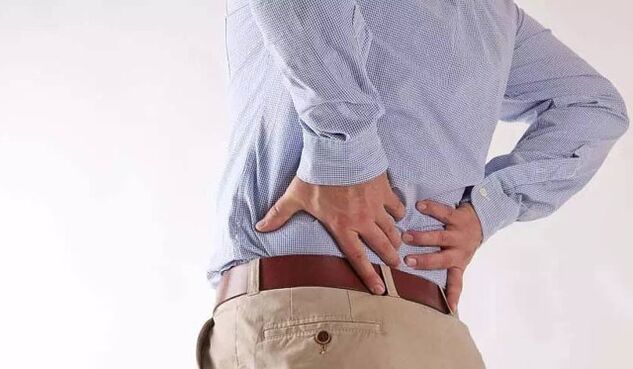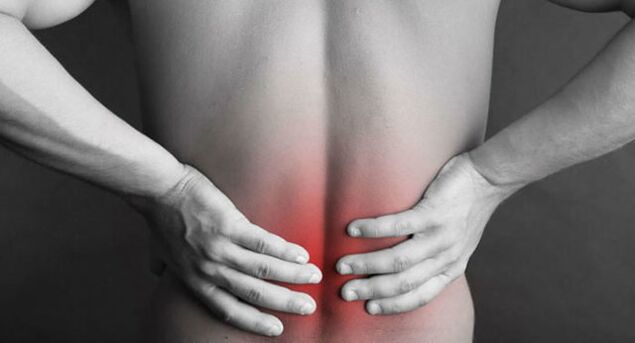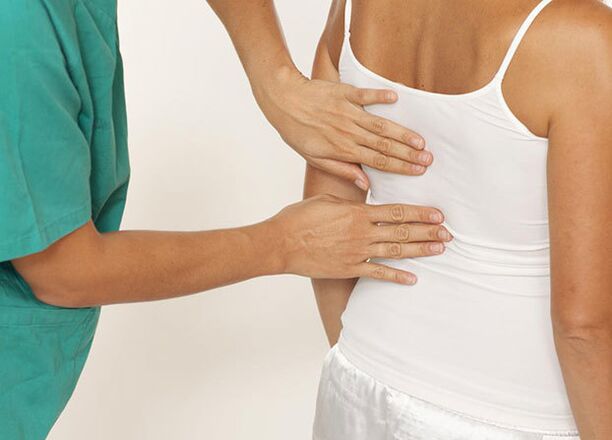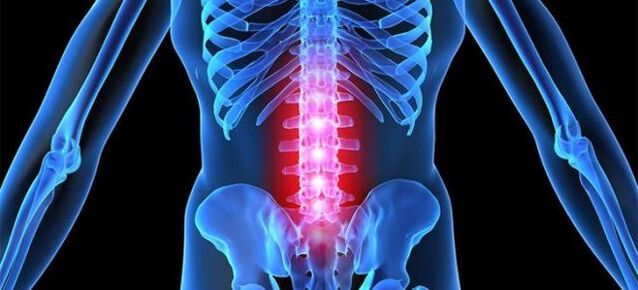About 80% of people over 55 experience manifestations of various diseases from the back, should not neglect the faces of younger age categories. Then, one of the most common diseases of the spinal-osteochondrosis column of the lumbar column is also found in 25-45-year-old patients. Even young people aged 16 to 25 suffer more and more symptoms and causes of this extremely unpleasant ailment. The question becomes logical about whether it is possible to stop the tendency of the number of patients in general, and what to do with each person for preventive purposes not to become a victim of this pathology?

Symptoms
With insufficient attention to this disease, inopportune diagnosis, its treatment is difficult because secondary diseases or complications occur. As a natural continuation of pathology, osteochondrosis begins to progress. Its treatment is not always effective, and when hardening or a therapeutic course prescribed incorrectly, there is a risk of disability. Another characteristic problem is the appearance of intervertebral hernias, which is accompanied by unbearable painful sensations. Every day, the chances of getting rid of irrevocable hernia are becoming less and less.
Characteristic clinical symptoms help recognize the disease in the early stages and avoid these sad consequences:
- Acute pain after night's dream;
- Pain with acute propagations of the body or raising heavy things;
- The body becomes inactive;
- Signs of scoliosis appear;
- The dream becomes restless;
- Depressive mood arise;
- Frequent urine is observed.
An independent evaluation of these symptoms cannot be correct, since most of them have a common similarity with the signs of other diseases in the column or the joints. Therefore, only a rheumatologist or orthopedist has a competition to talk about the presence of the development of the lumbar region.
Classification
Differential diagnosis to correctly determine the disease, distinguish it from identical pathologies and determine the treatment course, the classification of the stages of this ailment helps:
- Stage 1 - At this time, the cartilage structure is just beginning to change. But now, the pathological processes are affected by the roots of the nerve endings. As a result of this, pain occurs in the legs. At the same time, the blood flow worsens and inflammation is born. The pains are acute or stupid, and appear mainly only after reinforced loads on the axis of the back;
- The second stage begins with the destruction of the fibrous ring in the spine, while the cartilage is thinner, and the vertebrae reduces the distance from each other. The pain in the second stage is acute and sharp, sometimes unreasonable. During this period, the mobility of the column intensifies throughout the axis, nerve pinch are produced, pressure on the soft tissue of the muscle corset is created;
- Stage 3 is characterized by a strong compression of muscle fibers and nerve roots. In unbearable spasms and pain are produced with a burning character. In the area of defeat, numbness feels. With the intensive development of the disease, signs of paresis and paralysis appear;
- Stage 4 - The already formed osteophyte growth period (neoplasms with bone structure). At this stage, changes in a degenerative nature are activated, osteoarthritis in the column and joints appear. The back becomes inactive and in the absence of the right treatment, completely motionless.
Diagnostic methods
Since the ideal Knowledge of the Clinic and the Classification of osteochondrosis of the Lumbar Spine Does Not Give A Complete Idea Of The Pathological Process Processions Provoked By Him, A Doctor Who Is Enrolled In The Treatment of Pathological Process In The Spineprescribed an additional diagnostic examination:
- X -Ray in the frontal and lateral projection: it allows to identify the distortion of the axis, the formation of osteofites, anatomical anomalies of the vertebrae;
- Magnetic resonance determines the status of the entire subsequent damage zone, detects fragments of destroyed vertebrae, cartilage and inflammation spotlights;
- Computed tomography gives an idea of the condition of soft tissues, the bones of the vertebrae, the outer layer of the intervertebral disc, in principle, which is in principle for its integrity. and blood circulation in the area of location of the disease.

At the same time, the patient takes tests for rheumatoid test, general blood indicators, the content of biochemical components. The total survey results allow you to establish the diagnosis with precision and identify the stage of development of the osteochondrosis of the lumbar region.
Symptoms and treatment of the lumbar column osteochondrosis
Among the common causes of pain in the back, the osteochondrosis of the lumbar column, the symptoms, whose treatment has its characteristics characteristics. The disease is the initial stage of the osteochondrosis associated with the process of destruction of the cartilage ring, intervertebral discs, a change in its height towards the reduction, the formation of swelling and pinches of nerve roots. Young and elderly people can face the disease, regardless of gender, social status and religion. A long absence of the manifestation of the symptoms of the disease leads to the waste of precious time and the transition from a stage of the disease to more serious ways of its development. The main distinctive feature of osteochondrosis is the limit zone of distributing changes in the tissues of the vertebrae, which does not go beyond the articular cartilage.
Causes of the initial stage of osteochondrosis
Several external and internal factors determine the development of the pathological state of the lumbar region of the axial skeleton. Lumbar osteochondrosis appears due to certain risk factors. These include:
- Body aging after 50 years;
- inadequate posture and anomaly of the anatomical structure of the axial skeleton, which determines the unequal load in the vertebrae;
- lift weights with a weak muscle frame;
- hypothermia of the patient's body as a whole and lower back separately;
- Dysfunction of metabolic processes, endocrine organ work, cardiovascular system;
- Unequal charges in the column during the performance of production tasks, domestic tasks, professional and amateur sports;
- Pathologies of the musculoskeletal system of innate or acquired nature;
- Hypodinamia, high frequency of stressful situations;
- excess body weight of the patient;
- Lack of vitamins, minerals, elements trace in the body of a sick person, who are responsible for the health of the spine;
- Acquisition of high heel shoes, awkward platforms;
- The use of high pillows and soft mattresses during rest and sleep.
The frequency of the diagnosis of lumbar skeleton osteochondrosis is determined by the number of risk factors for their development that are present in the patient's life.
Disease diagnosis
The determination of the degenerative-experience lesion of one of the five vertebrae of the lumbar space of the axial skeleton provides diagnostic measures. They are prescribed by a doctor. In the consultation with a specialist who knows how to treat lumbar osteochondrosis, a history of the disease is collected, the time and characteristics of the manifestation of the signs, the intensity and the place of location of painful sensations are clarified. The condition of muscle fibers in the damage zone is determined by a visual exam. The use of the palpation method provides an opportunity for a doctor to see an image of the symmetry of the vertebrae and the distance between them. The final diagnosis is established after obtaining the results of additional studies. These include:

- X -ray, made in two projections and providing the opportunity to see the position of the vertebrae, the height of the discs, the seal of the marginal bone plates and the growth;
- Magnetic Resonance Images, which is a special research method to determine the state of the vascular system and fibrous rings in the degenerative-dystophical injury zone.
The objectives and methods of treatment of pathology
The results of the diagnostic measures are the basis of the treatment regime for the osteochondrosis of the lumbar lumbar skeleton, which pursues certain objectives. These include:
- a decrease in the intensity of pain caused by degenerative distribution lesions of one or more vertebrae of the lumbar skeleton;
- Standardization of metabolic processes in the cartilage, its restoration and exclusion of the risk of its greater destruction;
- reduction in load in nerve fibers;
- Increased blood flow in column tissues using massages, physiotherapeutic procedures;
- Strengthen the muscular framework of the axial skeleton through regular exercises of exercise therapy recommended by the instructor.
Condrosis therapy of the lumbar column, whose symptoms and treatment have their own characteristics, consists in taking and the use of pharmaceutical products, recipes of traditional medicine, methods of unconventional treatment, including hirudotherapy. An effective addition to solving the problem of pathology is physiotherapeutic, water, massage procedures, gymnastics and sports, including special exercise exercises. Pharmacological therapy includes the use of non -steroid anti -inflammatory drugs, muscle relaxants, condoprotectors, vitamin complexes with trace elements and minerals.
With very severe pain, novocaine or lidocaine blocks are prescribed, made by introducing injections in the affected places of the vertebrae. For local use, ointments, gels, creams, repairs with an anti -inflammatory heating effect are prescribed. Physiotherapeutic treatment includes the passage of electrophoresis healing courses, diadnamic currents, ultraviolet exposure, manual procedures, shock waves and reflexology. In the absence of positive dynamics, the appearance of herns, a surgical operation is prescribed. To avoid the development of complications with the appearance of the first symptoms, the treatment must begin immediately.
Lumbar osteochondrosis
Lumbar osteochondrosis is one of the most common forms of the underlying disease, actually osteochondrosis. Lumbar osteochondrosis, whose symptoms are equally determined by men and women, manifested in the form of pain concentrated in the sacrum area, reflected in their symptoms and the lower extremities, which often the patients determine as "pinch of the lumbar nerve".
Profusion for lumbar osteochondrosis
The protests in this area of interest for us develop more frequently, in addition, it is the bumps that cause the appearance of pain in the lower back. The lumbar region itself, given its location and characteristics, is more subject to the appearance of certain functional problems. That is, when considering this statement, on the one hand, it can be distinguished that our center of gravity refers directly to the Lumbar Department, respectively, it is precisely that a significant part of the charges accounts. When considering, on the other hand, it can be seen that a significant amplitude of movements, again, falls in this lumbar region. Given this, the greatest tendency to damage (as well as the protuberances of interest to us) is on the discs concentrated in the lumbar region. In addition, we must not forget that there are changes in the discs in this and, of course, in other areas, even in the context of the degenerative processes related to the age.
Remember our readers what are the bumps themselves. The connection of the discs with each other in the column is provided by the wheels based on the cartilage. The main components of the intervertebral disc are a jetty core and a fibrous ring, through which the fixation is provided within the framework of the spinal disc. The impact of certain factors and conditions causes the possibility of breaking this ring, at the bottom of which, in turn, the protuberance of the nucleus occurs. As a result of this process, hernia develops. As for the bump, it is already being developed as a result of a similar course of the process, but without the concomitant rupture of the ring; In this case, it is simply subject to thinning, and not a break, because the nucleus protrudes directly through the ring. Actually, this bump is defined as protrusion.
As for the symptoms of bump, it manifests itself as follows:
- a feeling of rigidity in the lower back;
- pain in the lumbar region;
- Inferior pain of chronic nature;
- lumbosacra radiculite;
- numbness, pain, tingling in the legs, on the feet;
- Altered urine functions (in rare cases of pathology under consideration).

Mainly, conservative treatment is applied to the bump of the lumbar disk. Meanwhile, significant in the development of bump is often accompanied by serious symptoms, resistant to treatment, in this case, it can no longer dispense with surgical intervention.
Treatment
Mainly the treatment of osteochondrosis is multicomponent and quite complicated in its implementation. Most of all therapy measures are reduced to the following points:
- Pharmacological treatment;
- if necessary - surgical treatment;
- diet;
- Medical Physical Education.
The exacerbation of the disease requires, in the first place, the fulfillment of the rest in the bed for the patients. The main recommendation for this part is a hard/hard place of sleep. Extremely expressed in manifestations, the attacks provide the need for a minimal motor load and in an early contact with the relevant specialist.






















